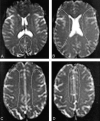Short-term changes in cerebral microhemodynamics after carotid stenting
- PMID: 13679259
- PMCID: PMC7973973
Short-term changes in cerebral microhemodynamics after carotid stenting
Abstract
Background and purpose: The cerebral hemodynamic sequelae of interventions in patients with severe internal carotid artery (ICA) stenoses are not fully understood. In this study, we sought to determine the immediate changes in cerebral perfusion characteristics, determined by MR imaging in patients who have undergone unilateral transluminal angioplasty and stent placement.
Methods: Eleven patients with symptomatic high-grade ICA stenosis underwent MR imaging within 4 hours before and within 3 hours after carotid stent placement. First-pass gadolinium-enhanced imaging of perfusion was performed by using a gradient-recalled echo-planar technique. Localized relative cerebral blood volume (rCBV) and bolus first-moment transit time (TT(FM)) were calculated for different vascular territories (middle, anterior, and posterior cerebral arteries) in each hemisphere.
Results: Significantly longer TT(FM) (P <.005) was observed in the symptomatic territory of the middle cerebral artery before intervention. After intervention, TT(FM) remained significantly longer in this territory (P <.05). However, the magnitude of the interhemispheric asymmetry had declined significantly (50-60% reduction; P <.05). No significant differences or changes in rCBV were identified between hemispheres, between images, or in areas of unilateral leptomeningeal enhancement after intervention.
Conclusion: MR can demonstrate short-term partial resolution of timing asymmetry in interhemispheric perfusion after angioplasty and stent insertion for severe stenosis of the ICA.
Figures



Comment in
-
Cerebral hemodynamics in carotid occlusive disease.AJNR Am J Neuroradiol. 2003 Sep;24(8):1497-9. AJNR Am J Neuroradiol. 2003. PMID: 13679257 Free PMC article. No abstract available.
Similar articles
-
Cerebral hemodynamics in asymptomatic patients with internal carotid artery occlusion: a dynamic susceptibility contrast MR and transcranial Doppler study.AJNR Am J Neuroradiol. 2001 Jun-Jul;22(6):1062-7. AJNR Am J Neuroradiol. 2001. PMID: 11415898 Free PMC article.
-
Hemodynamic changes of the cerebral circulation after stent-protected carotid angioplasty.AJNR Am J Neuroradiol. 2004 Aug;25(7):1162-7. AJNR Am J Neuroradiol. 2004. PMID: 15313702 Free PMC article.
-
Carotid stent delivery in an XMR suite: immediate assessment of the physiologic impact of extracranial revascularization.AJNR Am J Neuroradiol. 2005 Mar;26(3):531-7. AJNR Am J Neuroradiol. 2005. PMID: 15760861 Free PMC article.
-
Stenting for Internal Carotid Artery Stenosis Associated with Persistent Primitive Hypoglossal Artery Using Proximal Flow Blockade and Distal Protection System: A Technical Case Report and Literature Review.J Stroke Cerebrovasc Dis. 2016 Jun;25(6):e98-e102. doi: 10.1016/j.jstrokecerebrovasdis.2016.03.026. Epub 2016 Apr 19. J Stroke Cerebrovasc Dis. 2016. PMID: 27105567 Review.
-
Balloon Angioplasty for In-Stent Restenosis Resulting in Carotid Stent Fracture: Literature Review of Stent-in-Stent Technique as a Viable Therapeutic Option.World Neurosurg. 2017 May;101:818.e1-818.e6. doi: 10.1016/j.wneu.2017.01.127. Epub 2017 Feb 10. World Neurosurg. 2017. PMID: 28192264 Review.
Cited by
-
Perfusion-weighted magnetic resonance imaging in the assessment of haemodynamics following stent angioplasty in patients with symptomatic middle cerebral artery plaque stenosis at the M1 segment.Exp Ther Med. 2017 Sep;14(3):1899-1904. doi: 10.3892/etm.2017.4747. Epub 2017 Jul 9. Exp Ther Med. 2017. PMID: 28962101 Free PMC article.
-
The effect of carotid artery stenting on capillary transit time heterogeneity in patients with carotid artery stenosis.Eur Stroke J. 2018 Sep;3(3):263-271. doi: 10.1177/2396987318772686. Epub 2018 Apr 26. Eur Stroke J. 2018. PMID: 31008357 Free PMC article.
-
Carotid Artery Stenting and Blood-Brain Barrier Permeability in Subjects with Chronic Carotid Artery Stenosis.Int J Mol Sci. 2017 May 8;18(5):1008. doi: 10.3390/ijms18051008. Int J Mol Sci. 2017. PMID: 28481312 Free PMC article.
-
Quantitative assessment of external carotid artery territory supply with modified vessel-encoded arterial spin-labeling.AJNR Am J Neuroradiol. 2012 Aug;33(7):1380-6. doi: 10.3174/ajnr.A2978. Epub 2012 Feb 16. AJNR Am J Neuroradiol. 2012. PMID: 22345497 Free PMC article.
-
The role of neuroimaging in acute stroke.Ann Indian Acad Neurol. 2008 Jan;11(Suppl 1):S12-S23. Ann Indian Acad Neurol. 2008. PMID: 35721451 Free PMC article. Review.
References
-
- North American Symptomatic Carotid Endarterectomy Trial Collaborators. Beneficial effects of carotid endarterectomy in symptomatic patients with high grade carotid stenosis. N Eng J Med 1991;325:445–453 - PubMed
-
- European Carotid Surgery Trials Collaborative Group. Randomised trial of endarterectomy for recently symptomatic carotid stenosis: final results of the MRC European Carotid Surgery Trial (ECST). Lancet 1998;351:1379–1387 - PubMed
-
- CAVATAS investigators. Endovascular versus surgical treatment in patients with carotid stenosis in the carotid and vertebral artery transluminal angioplasty study (CAVATAS): a randomized study. Lancet 2001;357:1729–1737 - PubMed
-
- Yadav JS, Roubin GS, Iyer S, et al. Elective stenting of the extracranial carotid arteries. Circulation 1997;95:376–381 - PubMed
-
- Caplan LR, Hennerici M. Impaired clearance of emboli (washout) is an important link between hypoperfusion, embolism and ischaemic stroke. Arch Neurol 1998;55:1475–1482 - PubMed
MeSH terms
LinkOut - more resources
Full Text Sources
Miscellaneous
